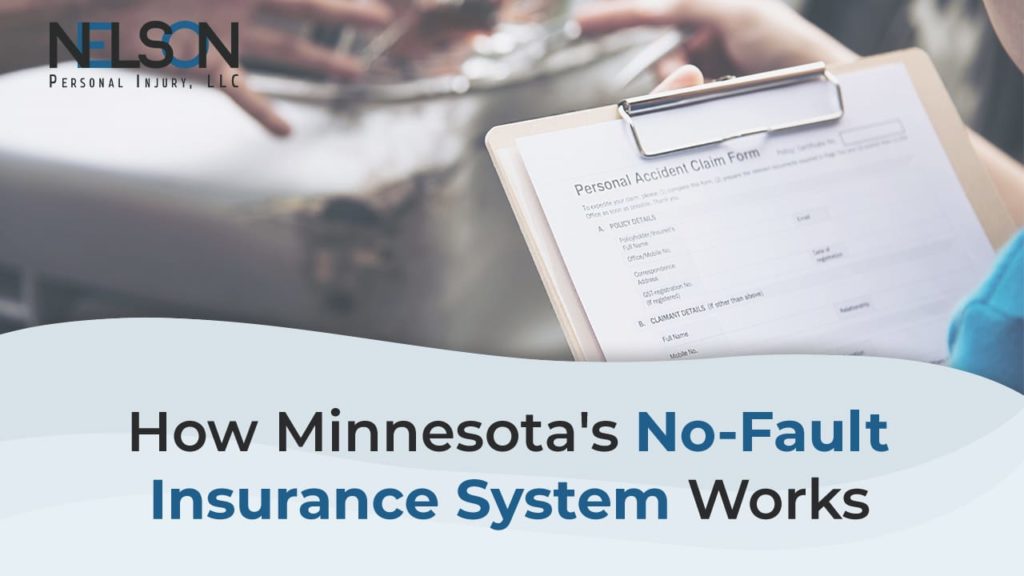Minnesota no-fault insurance
Minnesota is one of twelve “no-fault” insurance states in the country. There are many misconceptions about what being a no-fault insurance state actually means. Many people believe that it means that they cannot bring a claim against another party who caused a car accident. However, this is not true. Being a no-fault insurance state simply means that every Minnesotan who owns a motor vehicle (motorcycles and certain other vehicles excluded) is required by Minnesota law to carry basic minimum insurance coverages on that vehicle.
One of the required coverages is no-fault coverage (sometimes also referred to as “personal injury protection,” or “PIP” coverage). This coverage is to be used by anyone injured in a car accident, regardless of who is at fault for causing the accident. If another party is at fault for the accident, however, an injured party may step outside the no-fault system and pursue a claim against the at fault party in certain situations. Read on to learn all about the basics of Minnesota no-fault law.
Who is entitled to no-fault benefits?
The Minnesota No-Fault Automobile Insurance Act is designed to provide all Minnesota motorists with basic no-fault benefits in situations where they have sustained an injury “arising out of the maintenance or use of a motor vehicle.” These benefits are available regardless of who was at fault for causing the injury. These basic, minimum benefits include payment of $20,000 in medical expenses and mileage; as well as $20,000 in wage loss and replacement services benefits.
“Arising out of the maintenance or use” is defined broadly, and many people are surprised to learn that they may be entitled to no-fault benefits in situations beyond being involved in a car accident. Examples of other types of injuries that may be covered include injuries that occur while getting in or out of the vehicle (such as slipping and falling while entering or exiting the vehicle); injuries occurring while fueling or performing maintenance on the vehicle; certain injuries incurred while loading or unloading a vehicle, etc.
Because of the broad way in which Minnesota courts have defined “arising out of the maintenance or use of a motor vehicle,” if you have been injured and your injury was in any way connected with your motor vehicle, you should speak with an experienced Minnesota personal injury attorney to find out if you may be entitled to no-fault benefits.
What no-fault benefits are available?
Under Minnesota law, if you have been injured as a result of the maintenance or use of a motor vehicle, you will be entitled to the following minimum no-fault insurance coverage benefits:
- $20,000 for all reasonable, necessary, and related medical expenses, as well as reimbursement for your mileage to and from medical appointments or your reasonable transportation costs to and from medical appointments;
- $20,000 for income loss, or if self-employed, to hire replacement help. This benefit is limited to 85% of the lost wages, with a maximum of $500/week. Included in these benefits is reimbursement for replacement services. You may be entitled to replacement services benefits if your doctor restricts you from performing activities you normally would perform around your home, and you now have to hire someone to take care of those activities for you. Replacement services are paid out at a maximum of $200/week, but do not begin until seven (7) days after the accident; and
- In the event of a death, survivor’s benefits coverage up to $20,000, as well as funeral benefits up to $5,000.
These are mandatory minimum coverages, and again, you are entitled to collect these benefits even if you were “at-fault” for causing the accident. If you own multiple vehicles, and have elected to “stack” your no-fault benefits on your vehicles, your available benefit amounts will be multiplied by the number of vehicles you have elected to stack your coverage on. For example, if you have two vehicles, and have elected to stack your coverage, you will have $40,000 in medical expenses and mileage, and $40,000 in wage loss and replacement services coverage available to you.
Who pays your no-fault benefits?
The Minnesota No-Fault Automobile Insurance Act provides certain priorities of coverage for who will pay your no-fault benefits if you are injured in a car accident.
Generally, if you have been injured in a car accident, you will collect no-fault benefits from your own automobile insurance company. This is true even if you are not occupying your own vehicle at the time of the accident, or were a pedestrian.
If you did not own a vehicle, then the next priority would be any automobile insurance policy held by a relative who you live with. If you do not live with any relatives who have a car insurance policy, then you would obtain no-fault benefits from the vehicle you were occupying at the time of the accident, or if you were a pedestrian, the vehicle that hit you. If you are in a commercial vehicle or truck, in most cases, you collect from the commercial vehicle owner’s policy. If you have no coverages available through these priorities, you may be able to seek no-fault benefits through the Minnesota Automobile Assigned Claims Bureau.
Because of the complicated nature of priorities of no-fault coverage, you should consult with an experienced personal injury attorney who can review the facts of the situation and determine where you should obtain no-fault coverage.
What to do if you’re injured in an accident
If your injury arose “out of the maintenance or use of a motor vehicle,” you should take these steps to comply with the law and to safeguard your interests and rights as it pertains to your no-fault benefits:
- Report the accident to the police, highway patrol or sheriff’s office immediately.
- Report the accident as soon as possible to your insurance company. The law, and most likely your insurance policy, provides that insurers are entitled to prompt notice of accidents and claims. If it takes longer than six (6) months to report your claim, your insurance company may argue that they have been prejudiced by the delay and attempt to deny your no-fault benefits.
- Because of the inherent complexity of Minnesota no-fault law, it is recommended that you consult an experienced Minnesota personal injury lawyer to help assess your claim and determine whether you are entitled to no-fault benefits.
- Take photographs of any property damage to the vehicles and visible injuries you may have sustained.
- Do not admit fault, and do not give any written or recorded statement to any insurance company until you talk to an experienced Minnesota personal injury attorney.
- Seek medical treatment as soon as possible.
Obtaining no-fault benefits
In addition to reporting the accident to your insurance company, you may be required to complete a written application for no-fault benefits. The no-fault insurance company may require you to provide them with authorizations to obtain documents and records relevant to your medical treatment and expenses, income loss and replacement services claim. If you have any doubt about the appropriateness of the authorizations the insurance company is requesting that you sign, you should talk to an experienced Minnesota personal injury attorney.
The no-fault insurance company will provide you with a claim number. This claim number should be provided to your medical providers so that they can send their bills directly to the insurance company for payment. You should keep track of your mileage to and from your appointments, and submit that mileage to the no-fault insurance company for reimbursement.
If you are claiming lost wages, you will need to provide the no-fault insurance company with a note from a doctor restricting you from working, as well as proof of your lost income. If you are claiming replacement services benefits, you will need to provide the no-fault insurance company with a note from a doctor restricting you the specific activities, as well as receipts of payment made to others for performance of those activities.
An experienced Minnesota personal injury attorney can assist you in gathering all of the appropriate documentation to submit to your no-fault insurance company to ensure prompt payment of benefits.
Can my no-fault insurance company deny my benefits?
Your no-fault insurance company is only required to pay for you no-fault medical benefits if the treatment you have received is reasonable, necessary, and related to the motor vehicle accident. All no-fault insurance policies will require you to undergo a physical examination by a doctor chosen by your insurance company at their expense, at their request.
The physical examination is required to occur in your city, or as near as practical to your home. If the company demands your attendance for such an examination at a place other than where you live, you may wish to consult an attorney about your rights. If the insurance company’s doctor determines that your treatment is no longer reasonable, necessary, and related to the car accident, they may terminate your no-fault benefits.
In addition, Minnesota law also requires that you not have a lapse in treatment and disability of more than one (1) year to continue receiving benefits. If you have a one-year gap in treatment and disability, your insurance company can deny your no-fault benefits.
If your no-fault insurance company denies any of your benefits for any reason, and the amount of benefits at issue is $10,000 or less at the time of filing, you must file for no-fault arbitration. At a no-fault arbitration, a no-fault arbitrator will hear the case and determine whether the insurance company must pay your no-fault benefits. If the benefits at issue are greater than $10,000, you must file a lawsuit against the insurance company. In a lawsuit, a judge or jury will get to decide whether the insurance company must pay your no-fault benefits.
There are pros and cons to each course of action, and you should consult with an experienced Minnesota personal injury attorney to decide what course of action is best for your situation.
Stepping outside the no-fault system
Under Minnesota law, there are certain situations where you are able to step
outside the no-fault insurance system and pursue a claim against any party or parties who were at fault for causing your accident. In order to do so, you must prove that there was another party at fault for causing the accident; and prove that you have met one of Minnesota’s so called “no-fault thresholds” set forth in Minnesota § 65B.51:
- Medical treatment expenses of $4,000 or more (excluding the cost of x-rays); or
- A permanent injury; or
- A disability of 60 days or more; or
- A permanent scar or disfigurement; or
- A death as a result of the injuries.
If you meet one of these thresholds, you can step outside the no-fault insurance system and pursue a claim against any party or parties at fault for causing the accident. Under this claim, you may be entitled to recover your:
- Past and future medical expenses not covered by your no-fault claim;
- Past and future wage loss not covered by your no-fault claim; and
- Past and future pain, suffering, and emotional distress.
The importance of having an experienced Minnesota personal injury attorney to assist you with your no-fault claim
An experienced Minnesota personal injury attorney is trained to evaluate all aspects of your claim, including no-fault insurance claims. An injury victim’s rights are often prejudiced by delays in seeking representation while assuming the no-fault insurance company will take care of everything. Your attorney will ensure that your no-fault claim is set up with the proper insurance company, and all necessary documentation is gathered and provided so that benefits are paid promptly.
Many people whose no-fault benefits are cut off by their insurance company mistakenly believe that there is nothing they can do about it, and take no action. However, if your insurance company denies payment of your no-fault benefits, your attorney will help you file a lawsuit or file for arbitration to try to force the insurance company to pay for the benefits you are entitled to receive under Minnesota law.
If you have been injured, and a motor vehicle was involved, speak with one of our experienced personal injury attorneys as soon as possible to make sure you receive fair and adequate compensation under no-fault and Minnesota personal injury law.
Experienced personal injury attorneys handle cases on a “contingency fee” basis, which means that they do not get paid unless they recover money for you. Thus, delay in seeking help or advice from an attorney cannot be justified on the basis of “I cannot afford a lawyer.”
Conclusion
If you have been injured in an accident involving a motor vehicle, you may be entitled to no-fault benefits. Minnesota’s no-fault system can be complicated and confusing, but it is set up to try to provide prompt payment of benefits to those who have been injured in accidents, without taking into consideration fault. If you have any questions about your entitlement to no-fault benefits, or if your no-fault insurance company has cut off your benefits, call Nelson Personal Injury today for a free consultation.




